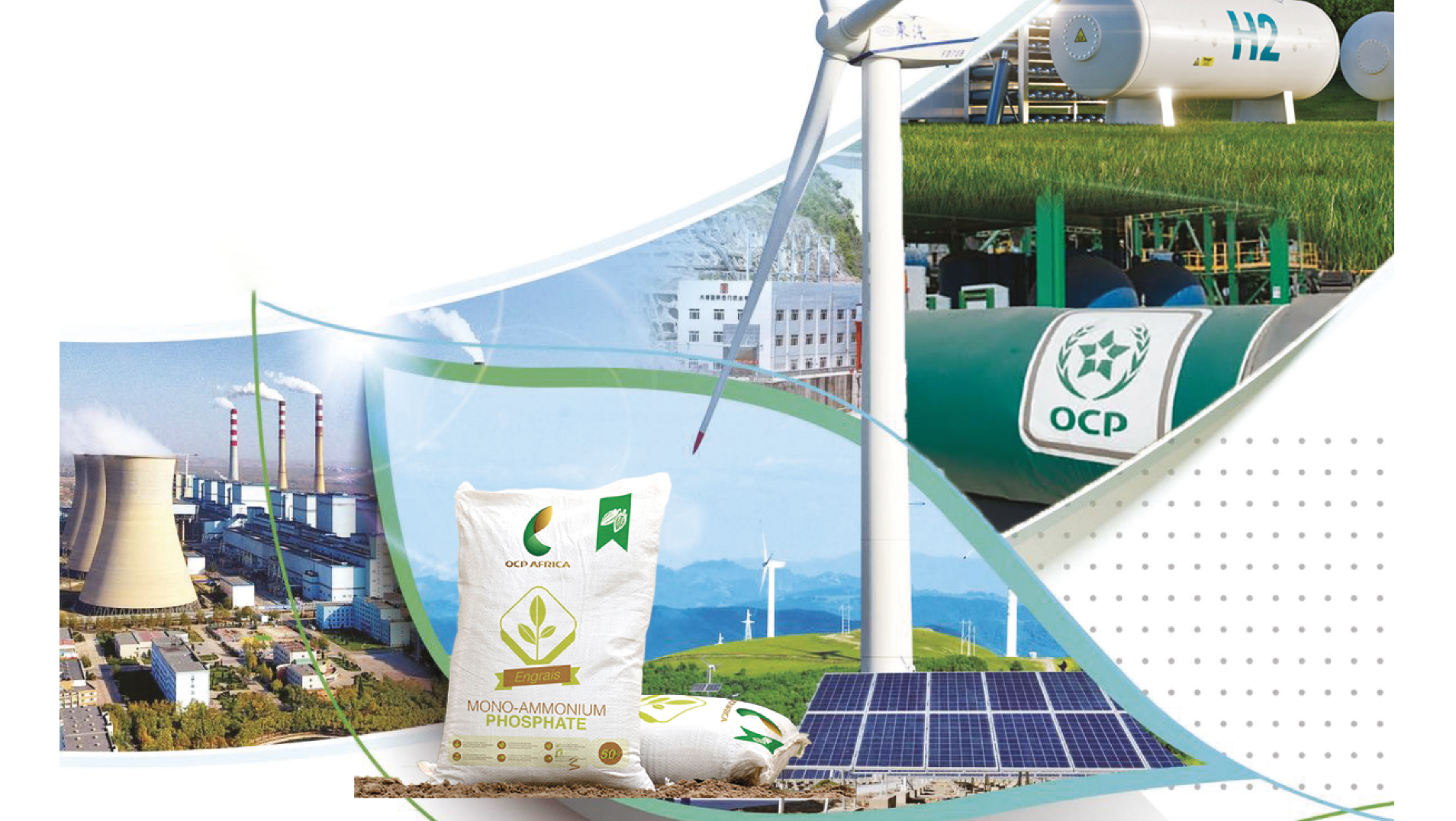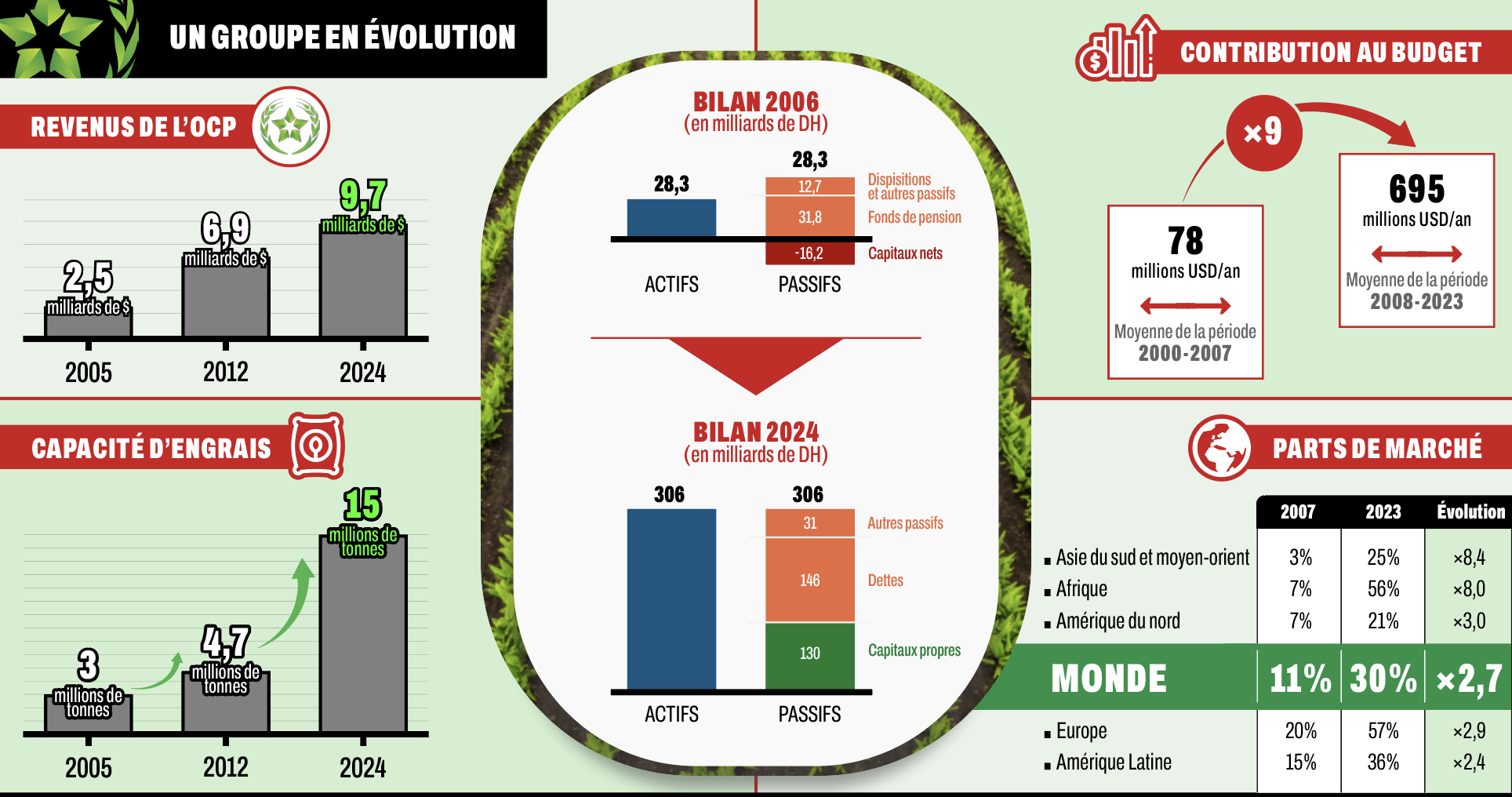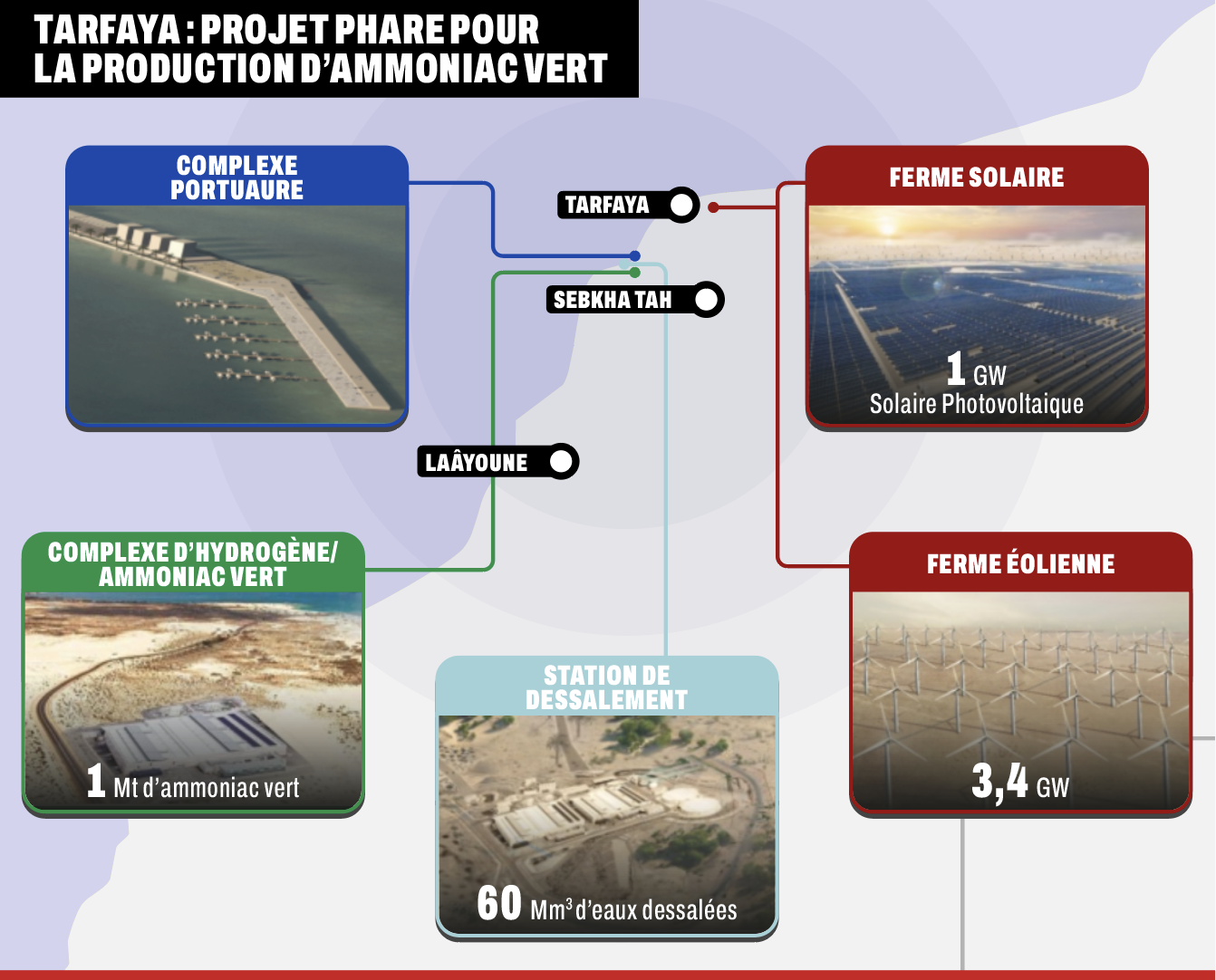Business
OCP: Successful Revolutions, Others In Progress
Desalinated energy and water, green hydrogen and ammonia, innovation and cutting-edge technology, data centers and supercomputers… The former public office, now a powerful multinational, positions itself as a catalyst for a revolution affecting multiple industrial sectors. An analysis of a vision aligned with national challenges.

Thursday, April 24. The OCP group successfully completes a new fundraising round totaling 1.75 billion dollars on the international market.
The financing conditions for these two bond tranches listed on the London Stock Exchange are almost as favorable as the last Eurobond issuance (2 billion dollars in 2024), despite a more uncertain market environment and even though the group’s debt has surged by 41% between 2023 and 2024: barely a 5-point bonus on the 10-year coupon between the two operations and a moderate risk premium (60 basis points) compared to sovereign debt, an insurmountable ceiling for OCP Group, yet rated ‘investment grade.’
In clear terms, OCP’s reputation continues to grow, confirming its solvency and, most importantly, the trust it enjoys from international investors who would never risk a single greenback without assessing the risk. This market verdict falls like a guillotine: it decisively cuts short those who question the group’s strategic vision by competing with ingenuity when faced with suspicious inquiries.
A state within a state? A hegemonic powerhouse extending its tentacles into branches far from its original mission? A monopoly that squanders the Kingdom’s underground riches through risky investments? A financial power seeking to lead the dance, even if it means stepping outside the realm of public projects? A diplomatic instrument spending freely in Africa? A dismissive management, afflicted with grandiosity and wanting to sell off a national jewel? And the list goes on…
But resorting to such shortcuts to describe the OCP group is either a sign of scripted bad faith or an astonishing misunderstanding of the group’s vision and future challenges. However, simply reviewing the transformation over the past 20 years of the former Office clarifies the image, highlights the relevance of various projects and initiatives undertaken, and also helps understand the upcoming challenges and obstacles shaping its development plan.
The group’s strategic coherence is obvious, clear as day; the value of this shared asset leaves no room for doubt but instead provokes acid reflux among its global competitors. Moreover, the seeds of the public company’s development appear already well planted and fertilized. Back to the future…
Institutional Revolution
The transformation of OCP is based on a triangulation of strategic axes, outlined by Mostafa Terrab shortly after his appointment as head of the Royal Office of Phosphates in 2006. Product valorization, cost reduction, and industrial flexibility constitute a triptych that remains relevant for the company, which has already carried out its structural, financial, and industrial revolution despite heading straight toward bankruptcy.
Because in 2006, OCP was experiencing its fifth consecutive year of losses, and its commercial and financial performance was far from the staggering figures presented at the latest board meeting (see infographic). Listing the dysfunctions that lasted for decades within the Office would be as lengthy as the thick audit commissioned by Terrab to exercise his right of inventory — the famous Kroll report.
“In crawl, any other leader would have crossed the Atlantic to return to the United States if he had been in the position of this high public official who had nothing left to prove,” jokes a former employee of the Office who had access to the pamphlet. “OCP was bankrupt with negative assets, burdened, among other things, by an internal pension fund: a time bomb of 32 billion dirhams at the time,” he summarizes.
However, Terrab is not the kind of man to look in the rearview mirror or lament over past lost opportunities. He is rather of the type of leader who prefers to project into the future, innovate in terms of solutions, and create new opportunities. Out with the internal pension fund (replaced by a cross-participation with BCP), a prerequisite for transforming into a Public Limited Company, and OCP is already passing the test of the institutional revolution.
Managerial Revolution
The company’s commercial strategy will also undergo a shake-up. Long-term contracts indexed to phosphate prices dating back to the 1970s are now being revised: OCP shifts to spot trading to elevate its position (never contested) from the top exporter of phosphates to a market-maker.
The volatility of this raw material market no longer causes tremors but is instead managed to capture more value. Faced with the yo-yo of global phosphate prices, OCP responds by adjusting its production, slowing down its excavation machinery while investing in valorization, even if it temporarily concedes market share and causes discomfort among public financiers.
“It must be acknowledged that the shareholder state has been understanding, and the board of directors supported this new vision,” recalls our source. He adds: “The directors were aware that public finances would benefit from a rational profit distribution approach rather than persisting in draining the modest fixed royalty of a monopoly.”
Looking back, indeed, the state’s accounts have little to complain about: the average annual contribution of OCP to the public budget (through taxes, levies, and dividends) over the past 15 years is around 7 billion dirhams… nearly ten times more than the average receipts of 750 million dirhams, between 2000 and 2008, which were almost entirely composed of monopoly taxes.
Industrial Revolution
The minimization of this monopoly royalty fee at the time helped to unlock the investment potential of the public company, which became a joint-stock company (SA), and can now rely on private financing.
Thus, OCPSA made its first entry into the Casablanca financial market in 2011, presenting restated and certified accounts. It chose a bond issuance rather than a capital opening, as a chairman might have preferred, enchanted by the tempting sirens of privatizations that were in vogue. “Law 46-07, which transformed OCP into a joint-stock company, simply states that the shareholder State must remain the majority,” explains a source close to OCP. “Nothing prevents the board of directors from approving a capital opening,” he adds. “But considering it remains unlikely as long as Terrab is in charge. We tend to forget that he left the ANRT because he was fiercely opposed to the privatization mode of Maroc Telecom,” recalls our source, seemingly dismissing rumors of privatizing Nutricrops (see p.33).
On this first engagement with the market, OCP also revealed an investment program (2010–2020) amounting to approximately 100 billion dirhams. In mining, chemistry, agriculture, and the environment, the group is investing heavily to modernize and strengthen its production capacity, improve its competitiveness on all fronts to solidify its status as the leading phosphate exporter, and also to rise to the rank of a global leader in the fertilizer market.
Slurry pipelines, phosphate washing plants using recycled water from treatment stations, the phosphate hub of Jorf Lasfar with its chemistry complex, desalination plant, and mini-co-generation power plants, agriculture funds, soil mapping programs in Morocco and Africa… the strategic projects number in the dozens and are successfully led by a strengthened and renewed top management.
Today, OCP’s programs have become “Case Studies,” showcased in the most prestigious American universities, including Cambridge, Harvard, and Columbia…
Customized Fertilizers
OCP has skillfully shifted into a higher stratosphere, shining as an influential global enterprise. With exclusive access to the world’s largest phosphate deposits (70% of the exploitable reserves), the group has managed to reverse its revenue curve across all segments: these have quadrupled over 20 years to nearly 100 billion dirhams in 2024, thanks to better valorization of the raw material extracted from Moroccan subsoil.
While it was minimally involved in downstream activities—contributing only 11% of fertilizer sales in 2005—OCP now generates between 65 and 70% of its revenue from these products. Regarding these fertilizers, which now contribute around 50% of global food production, the company has risen to become the top producer, with an installed capacity of 15 million tonnes, nearly tripling its global market share (30% in 2023).
In this area, OCP demonstrates innovation: the traditional DAP formula is on the path to extinction in favor of customized fertilizers tailored to soil types and crops. The group has mapped more than 50 million hectares across 13 countries and analyzed twice as many hectares via satellite.
This has allowed it to develop 44 tailor-made fertilizer formulas, already proven on 5,000 demonstration plots: yield increases can range from 30% to 100%, as demonstrated by various experiments conducted on farms from Ethiopia to Senegal, including Kenya, Rwanda, Nigeria, and Ghana.
The African Granary
One of the key catalysts for this dynamism in the African market is none other than the creation of OCP Africa. “Selling customized fertilizer in Africa was a new business for the group. It was necessary to separate it clearly from the trade of ‘traditional’ products while providing this structure with the means to demonstrate the relevance of this new product and approach on a continent where the low application of fertilizers limits agricultural productivity, even though Africa holds 60% of the world’s unused arable land,” explains an expert familiar with the African ecosystem.
In fact, Africa is a strategic market for OCP: the group sells around 2.7 million tonnes of fertilizer annually. This gives it 56% market share with products that are cheaper and better adapted than those of its competitors, thanks, among other things, to blending factories in Rwanda and Kenya. “And it’s fortunate that OCP’s strategy aligns perfectly with the royal vision of increased cooperation with the African continent,” highlights our source.
Moreover, the parallel between OCP’s approach and national interests is not limited to its positioning on the African continent… it extends to many other strategic industrial sectors.
Coherent Investments
Water management is a fairly representative example to illustrate this intersection between OCP’s investments and public policies. Already a pioneer in recycling water supplied by treatment plants for its washing facilities, as well as in seawater desalination (to meet the needs of its industrial complexes), OCP was, for example, instrumental in supplying drinking water to the cities of Safi, El Jadida, and Casablanca during last summer’s peak water stress, thanks to its historic desalination stations in Jorf and Safi.
The company’s goal is to eventually eliminate the use of surface water for its industrial needs. Its 2023-2027 development plan includes treating and desalinating around 560 million m³ of water in this respect.
Since energy is the main input for this process, OCP is committed to renewable sources, just as the Kingdom does with its energy mix. Especially since the company already has expertise in this area through its cogeneration plants, which convert heat generated by its chemical factories into electricity sufficient to supply its industrial complex and its desalination station.
Furthermore, OCP has innovated in electrical storage through the development of a patented technology: unique electrolytes for “redox flow” batteries, as well as the start of production of an active cathode material based on lithium, iron, and phosphate (LFP). “These innovations, among others, are credited to the ecosystem of Mohammed VI Polytechnic University,” emphasizes our source (see p.34).
Ammonia in Tarfaya
Thus, by 2027, OCP aims to produce up to 30,000 tonnes of LFP and to increase its energy capacity to around 5 gigawatts. Its electrolysis technology is being used to produce green hydrogen.
A project with Engie is underway, supporting the Moroccan offer for green hydrogen, which is attracting several international investors. “Claiming that these two plans clash, just as claiming that the electric transport network between OCP’s industrial sites overlaps with ONEE’s electric highway, is a big misunderstanding,” explains this close source.
OCP seeks to meet its needs and ensure coherence in its industrial model through these investments led by a state-owned company that remains at the service of the State, he adds.
Indeed, if OCP is positioning itself in green hydrogen, it is to replace natural gas in producing green ammonia. A crucial input for the group’s future commercial policy, which intends to shift toward 100% customized fertilizers with a decarbonized industrial and logistical process. “All studies and projections show that green ammonia is more competitive,” our source emphasizes.
OCP is therefore far from embarking on reckless projects: the pieces of the puzzle are fitting together to realize a competitive industrial integration. The complex planned southeast of Tarfaya exemplifies the coherence of these multi-sector investments.
The plan includes a port quay, a solar farm, a wind farm, a desalination plant, hydrogen electrolyzer factories… all serving a green ammonia complex with a capacity of one million tonnes by 2027. “It is underway, and the objectives and deadlines will be met,” reassures this close-to-the-group source.
The success of this ambitious development plan depends necessarily on unleashing all energies and synergies of this giant that OCP has become. That is why its organizational architecture has been redesigned into Strategic Business Units, allowing each to have full autonomy to mobilize the necessary human, technological, and financial resources to create ecosystems.
And the idea of creating a large portfolio fund capable of directing investments in this direction is gaining momentum and already attracting national investors (see p.32). An approach still innovative, capable of propelling the OCP group into a new dimension.
Let’s bet that we will revisit, in less than 15 years, to list all the successful achievements of this new revolution of the good old century-old Office, which knows how to traverse ages and stay at the forefront!
















